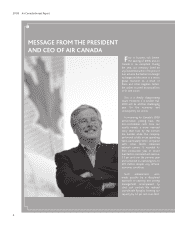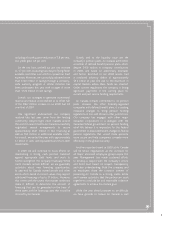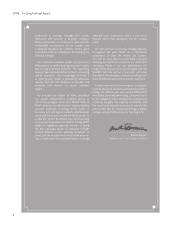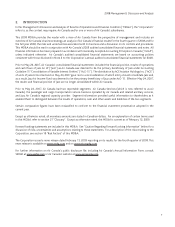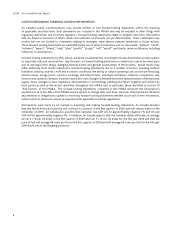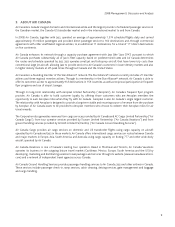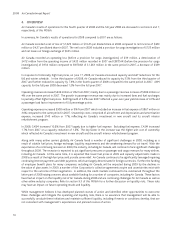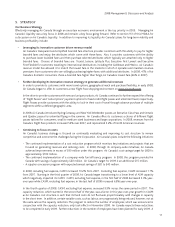Air Canada 2008 Annual Report Download - page 14
Download and view the complete annual report
Please find page 14 of the 2008 Air Canada annual report below. You can navigate through the pages in the report by either clicking on the pages listed below, or by using the keyword search tool below to find specific information within the annual report.2008 Air Canada Annual Report
14
Additionally, in 2008, Air Canada enhanced its flight notification product which enabled it to provide customers with
more information with respect to changes to their travel plans.
In 2009, Air Canada is planning to continue to introduce new self-service products and enhance its applications to
simplify the customer’s experience before travel. Air Canada plans to introduce new languages to its kiosk application
(Korean, German, Chinese Mandarin, Japanese, and Spanish). Additionally, mobile native applications will be available
for customers using smartphones (iPhone, BlackBerry, etc.) where a complete set of services will be offered to
the customer, enhancing the user experience. Air Canada plans to introduce the electronic boarding pass to select
stations in the US and in Europe. Finally, the new early check-in product will provide customers with the possibility
of registering for check-in as soon as their reservation is complete and receive a boarding pass to their e-mail or
mobile device 24 hours before departure.
NetLine
The legacy technology of Air Canada’s current flight operations systems has been replaced by the NetLine system,
an integrated software suite. The new system is designed to enable Air Canada to enhance operational efficiencies
by providing better real-time operational information. Furthermore, NetLine allows for an easier and more cost
effective adaptation to changes in Air Canada’s operational needs by leveraging new generation technology.
OASIS
Online Aircraft Support Integrated Solution, or OASIS, is a corporate initiative to upgrade the current legacy
maintenance and engineering system - referred to as ARTOS. The maintenance and engineering system provides the
organization with fleet status and maintenance planning; technical records of the fleet; configuration control and
airworthiness compliance; materials management and planning.
With the increasing complexity of today’s operation, the decision was made to replace the existing applications
with a cost competitive and integrated platform. The platform is designed to provide the functionality required by
Air Canada’s maintenance division as well as a product foundation which can be leveraged to implement future
enhancements and is also designed to provide Air Canada with improved aircraft availability, resource and asset
efficiencies and management information while reducing information technology expenses.
In 2008, Air Canada began the design phase of the project with subsequent releases of the functional phases expected
throughout 2009 and 2010. In 2009, Air Canada plans to finalize the development of the solution and begin its
deployment in the latter part of 2009. The deployment strategy is one of a phased implementation that is expected
to be rolled out throughout 2009 and 2010.
• Maintainingpositiveemployeeandlabourrelations
In Canada, Air Canada has collective agreements with its pilots, flight attendants, maintenance personnel, certain
clerical and finance personnel, customer service agents, ramp and cargo employees and dispatchers which were
concluded in 2003 and 2004 and which expire in 2009. Collective agreements with two groups of crew schedulers
also expire in 2009. No strikes or lock-outs may lawfully occur during the term of the collective agreements.
On December 19, 2008, Air Canada announced that its US-based customer service workforce, represented by the
International Brotherhood of Teamsters (IBT), ratified its labour agreement. The IBT represents approximately 650
Air Canada airport, cargo and call centre employees based in the United States. The three year agreement takes
effect on July 1, 2009.
On January 14, 2009, Air Canada announced that it had reached a tentative, three-year labour agreement with the
Canadian Auto Workers (CAW) Local 2002. The agreement was subject to a ratification vote by union members.
The CAW represents approximately 5,000 customer sales and service agents employed by Air Canada. The tentative
agreement also provided for a detailed plan for Air Canada employees currently working in the Aeroplan call centres
to transition to employment at Aeroplan or remain at Air Canada. Similarly, affected Air Canada employees would
also have been able to request a transfer to Aeroplan. On January 28, 2009, Air Canada announced that it had been
advised by the CAW Local 2002 that the tentative agreement reached by the parties on January 14, 2009 was not
ratified by its membership.


